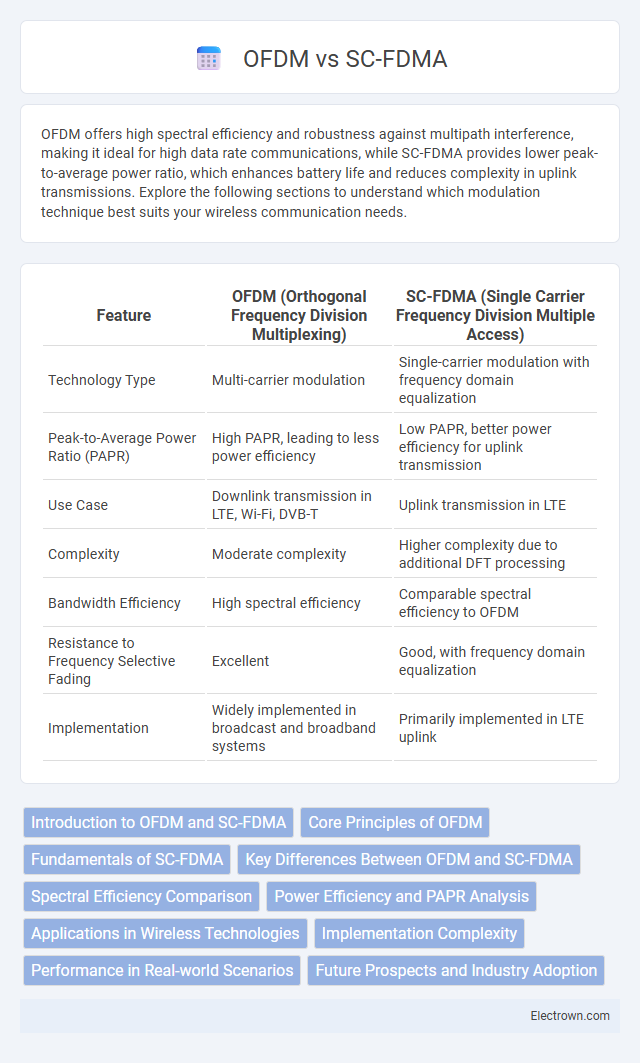OFDM offers high spectral efficiency and robustness against multipath interference, making it ideal for high data rate communications, while SC-FDMA provides lower peak-to-average power ratio, which enhances battery life and reduces complexity in uplink transmissions. Explore the following sections to understand which modulation technique best suits your wireless communication needs.
Table of Comparison
| Feature | OFDM (Orthogonal Frequency Division Multiplexing) | SC-FDMA (Single Carrier Frequency Division Multiple Access) |
|---|---|---|
| Technology Type | Multi-carrier modulation | Single-carrier modulation with frequency domain equalization |
| Peak-to-Average Power Ratio (PAPR) | High PAPR, leading to less power efficiency | Low PAPR, better power efficiency for uplink transmission |
| Use Case | Downlink transmission in LTE, Wi-Fi, DVB-T | Uplink transmission in LTE |
| Complexity | Moderate complexity | Higher complexity due to additional DFT processing |
| Bandwidth Efficiency | High spectral efficiency | Comparable spectral efficiency to OFDM |
| Resistance to Frequency Selective Fading | Excellent | Good, with frequency domain equalization |
| Implementation | Widely implemented in broadcast and broadband systems | Primarily implemented in LTE uplink |
Introduction to OFDM and SC-FDMA
OFDM (Orthogonal Frequency Division Multiplexing) and SC-FDMA (Single Carrier Frequency Division Multiple Access) are advanced modulation schemes used in wireless communication systems. OFDM divides a wideband channel into multiple orthogonal subcarriers, enabling high spectral efficiency and robustness against multipath fading. SC-FDMA, employed in uplink LTE, combines single-carrier transmission with frequency domain equalization to reduce peak-to-average power ratio, enhancing power efficiency for mobile devices.
Core Principles of OFDM
OFDM (Orthogonal Frequency Division Multiplexing) transmits data by dividing the signal into multiple orthogonal subcarriers, each modulated independently to reduce inter-symbol interference and combat multipath fading. This multicarrier approach enhances spectral efficiency and resilience in broadband wireless communication systems, such as LTE and Wi-Fi. The core principle relies on precise orthogonality of subcarriers achieved through FFT/IFFT processing, enabling simultaneous data transmission over frequency-selective channels with minimal interference.
Fundamentals of SC-FDMA
SC-FDMA (Single Carrier Frequency Division Multiple Access) uses a single-carrier modulation technique combined with frequency domain equalization, offering lower Peak-to-Average Power Ratio (PAPR) compared to OFDM. This makes SC-FDMA more power-efficient and suitable for uplink transmission in LTE and 5G networks. The fundamental principle involves spreading a user's data symbols over multiple subcarriers using discrete Fourier transform before transmission, which reduces signal distortion and improves battery life in mobile devices.
Key Differences Between OFDM and SC-FDMA
OFDM (Orthogonal Frequency Division Multiplexing) uses multiple closely spaced subcarriers to transmit data simultaneously, providing high spectral efficiency and robustness against multipath fading. SC-FDMA (Single Carrier Frequency Division Multiple Access) combines single-carrier transmission with frequency domain equalization, resulting in lower Peak-to-Average Power Ratio (PAPR) and improved power efficiency, making it ideal for uplink transmissions in mobile networks. Understanding these key differences helps you optimize communication system design for either downlink (OFDM) or uplink (SC-FDMA) applications.
Spectral Efficiency Comparison
OFDM offers higher spectral efficiency in multipath environments due to its ability to divide the spectrum into multiple orthogonal subcarriers, maximizing data throughput within limited bandwidth. SC-FDMA, while less spectrally efficient than OFDM, provides lower Peak-to-Average Power Ratio (PAPR), enhancing power efficiency for uplink transmissions in LTE networks. Your choice between OFDM and SC-FDMA should consider the trade-off between spectral efficiency and power consumption based on the specific communication scenario.
Power Efficiency and PAPR Analysis
OFDM generally exhibits higher peak-to-average power ratio (PAPR) compared to SC-FDMA, leading to less power-efficient transmitter operation due to increased linearity requirements in power amplifiers. SC-FDMA's single-carrier structure inherently reduces PAPR, which enhances power efficiency and prolongs battery life in mobile devices. Your system can benefit from SC-FDMA's lower PAPR, especially in uplink transmissions where power efficiency is critical.
Applications in Wireless Technologies
OFDM powers many high-speed wireless technologies like Wi-Fi 6 and 5G NR downlink, offering robust multipath resistance and high spectral efficiency critical for dense urban environments. SC-FDMA is primarily used in LTE uplink transmissions due to its low peak-to-average power ratio, which extends battery life in mobile devices and improves power amplifier efficiency. Choosing between OFDM and SC-FDMA impacts your wireless system's performance by balancing complexity, energy consumption, and data throughput in different network scenarios.
Implementation Complexity
OFDM (Orthogonal Frequency Division Multiplexing) exhibits higher implementation complexity than SC-FDMA (Single Carrier Frequency Division Multiple Access) due to its multicarrier modulation requiring multiple FFT/IFFT operations. SC-FDMA leverages a single-carrier structure with a DFT precoding step that simplifies the transmitter design, reducing the power amplifier linearity constraints and computational load. Your choice between these technologies should consider that SC-FDMA offers lower peak-to-average power ratio (PAPR) and thus a more energy-efficient and less complex implementation, especially critical for uplink transmissions in mobile devices.
Performance in Real-world Scenarios
OFDM offers robust performance in multipath environments by efficiently handling frequency-selective fading, making it ideal for high-data-rate wireless communication. SC-FDMA provides lower peak-to-average power ratio (PAPR), which enhances power efficiency and extends battery life in uplink transmissions such as mobile networks. Your choice between OFDM and SC-FDMA should consider the trade-offs between spectral efficiency and power consumption based on the deployment scenario.
Future Prospects and Industry Adoption
OFDM (Orthogonal Frequency-Division Multiplexing) remains the preferred choice for future wireless technologies such as 5G and beyond due to its spectral efficiency and robustness in multipath environments. SC-FDMA (Single Carrier Frequency Division Multiple Access) maintains strong industry adoption in uplink transmissions for LTE and emerging IoT devices because of its lower peak-to-average power ratio, which enhances power efficiency in mobile terminals. Your network design decisions should consider OFDM for downlink performance optimization and SC-FDMA for energy-efficient uplink communication in evolving 5G ecosystems.
OFDM vs SC-FDMA Infographic

 electrown.com
electrown.com